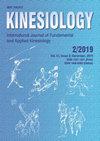Position-related differences in morphological characteristics of u14 female handball players
IF 0.9
4区 医学
Q4 REHABILITATION
引用次数: 6
Abstract
The aim was to establish differences in morphological characteristics of 48 selected female younger cadet (U14) handball players (age 13.88±0.46 years) in the playing positions of wings, backs and pivots. The sample of variables embraced 24 morphological measures defining the already established four latent body dimensions. Univariate ANOVA revealed the significant global differences among the three groups of U14 players in 11 morphological measures. Between the backs and pivots no significant differences were established. The greatest differences between the pivots and wings were established in body height, leg length, arm length, ankle breadth, body weight and calf circumference (p<.01). The greatest differences between the wings and backs were established in four variables: body height, arm length, knee breadth and ankle breadth (p<.01). We endorse the interpretation that specificities of technical-tactical activities executed by backs and pivots in attack repose in the background of the established differences, that is, backs and pivots are exposed to more body contacts in attack in which they must overcome defenders’ resistance. In the sample of the Croatian U14 female handballers apparently no somatotypic component prevailed. However, a slightly larger contribution of endomorph component was perceived in the pivots’ body composition, which was in line with the general results of the entire age group. In U14 backs both the endomorph and mesomorph component were pronounced equally, whereas all the three components were of even values in the wings.u14女子手球运动员形态特征的位置相关差异
本研究旨在确定48名年龄为13.88±0.46岁的U14年轻女子手球运动员在翅膀、背部和支点位置上的形态特征差异。变量样本包括24个形态学指标,定义了已经建立的四个潜在身体维度。单变量方差分析显示,三组U14球员在11项形态学指标上存在显著的全局差异。背部和枢轴之间没有明显差异。枢轴和翅膀之间的最大差异是在身高、腿长、臂长、脚踝宽度、体重和小腿周长方面(p<0.01)。翅膀和背部之间的最大差值是在四个变量中确定的:身高、臂长,膝盖宽度和脚踝宽度(p<0.01)。我们赞同这样的解释,即背部和支点在进攻中执行的技战术活动的特殊性取决于既定差异的背景,也就是说,在进攻中,背部和支点暴露在更多的身体接触中,必须克服防守队员的抵抗。在克罗地亚U14女子手球运动员的样本中,显然没有任何体型成分占主导地位。然而,在枢轴的身体组成中,内变形成分的贡献略大,这与整个年龄组的总体结果一致。在U14背部,内变形和中变形成分的发音相同,而所有这三个成分在翅膀中的值都相等。
本文章由计算机程序翻译,如有差异,请以英文原文为准。
求助全文
约1分钟内获得全文
求助全文
来源期刊

Kinesiology
REHABILITATION-SPORT SCIENCES
CiteScore
1.90
自引率
8.30%
发文量
16
审稿时长
>12 weeks
期刊介绍:
Kinesiology – International Journal of Fundamental and Applied Kinesiology (print ISSN 1331- 1441, online ISSN 1848-638X) publishes twice a year scientific papers and other written material from kinesiology (a scientific discipline which investigates art and science of human movement; in the meaning and scope close to the idiom “sport sciences”) and other adjacent human sciences focused on sport and exercise, primarily from anthropology (biological and cultural alike), medicine, sociology, psychology, natural sciences and mathematics applied to sport in its broadest sense, history, and others. Contributions of high scientific interest, including also results of theoretical analyses and their practical application in physical education, sport, physical recreation and kinesitherapy, are accepted for publication. The following sections define the scope of the journal: Sport and sports activities, Physical education, Recreation/leisure, Kinesiological anthropology, Training methods, Biology of sport and exercise, Sports medicine and physiology of sport, Biomechanics, History of sport and Book reviews with news.
 求助内容:
求助内容: 应助结果提醒方式:
应助结果提醒方式:


